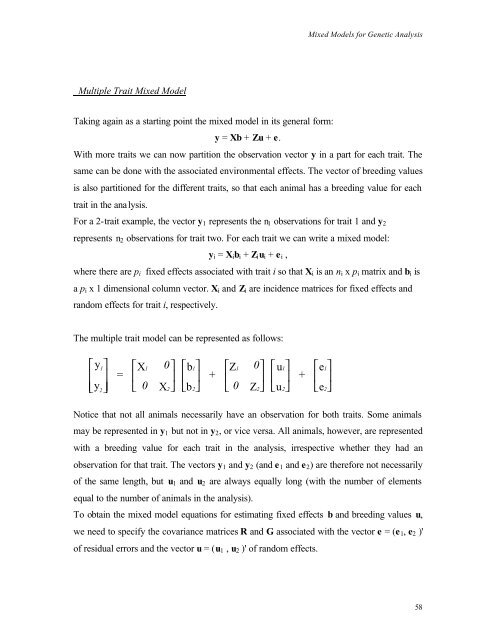Mixed Models for Genetic analysis
Mixed Models for Genetic analysis
Mixed Models for Genetic analysis
Create successful ePaper yourself
Turn your PDF publications into a flip-book with our unique Google optimized e-Paper software.
<strong>Mixed</strong> <strong>Models</strong> <strong>for</strong> <strong>Genetic</strong> AnalysisMultiple Trait <strong>Mixed</strong> ModelTaking again as a starting point the mixed model in its general <strong>for</strong>m:y = Xb + Zu + e.With more traits we can now partition the observation vector y in a part <strong>for</strong> each trait. Thesame can be done with the associated environmental effects. The vector of breeding valuesis also partitioned <strong>for</strong> the different traits, so that each animal has a breeding value <strong>for</strong> eachtrait in the <strong>analysis</strong>.For a 2-trait example, the vector y 1 represents the n 1 observations <strong>for</strong> trait 1 and y 2represents n 2 observations <strong>for</strong> trait two. For each trait we can write a mixed model:y i = X i b i + Z i u i + e i ,where there are p i fixed effects associated with trait i so that X i is an n i x p i matrix and b i isa p i x 1 dimensional column vector. X i and Z i are incidence matrices <strong>for</strong> fixed effects andrandom effects <strong>for</strong> trait i, respectively.The multiple trait model can be represented as follows:⎡y1⎤⎢ ⎥⎣⎢y2⎦⎥=⎡X1⎢⎣ 00⎤b1⎥ ⎡X2⎦⎣ ⎢⎤⎥b2⎦+⎡Z1⎢⎣ 00⎤u1⎥ ⎡Z2⎦⎣ ⎢⎤⎥u2⎦+⎡e1⎢ ⎤ ⎣e2⎦ ⎥Notice that not all animals necessarily have an observation <strong>for</strong> both traits. Some animalsmay be represented in y 1 but not in y 2 , or vice versa. All animals, however, are representedwith a breeding value <strong>for</strong> each trait in the <strong>analysis</strong>, irrespective whether they had anobservation <strong>for</strong> that trait. The vectors y 1 and y 2 (and e 1 and e 2 ) are there<strong>for</strong>e not necessarilyof the same length, but u 1 and u 2 are always equally long (with the number of elementsequal to the number of animals in the <strong>analysis</strong>).To obtain the mixed model equations <strong>for</strong> estimating fixed effects b and breeding values u,we need to specify the covariance matrices R and G associated with the vector e = (e 1 , e 2 )'of residual errors and the vector u = (u 1 , u 2 )' of random effects.58
















